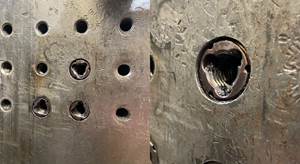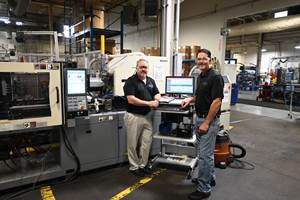Novel Process Assembly, Safety, Environmental Applications from 2017 SPE Auto Innovations Finalists
First application of torsional welding (spin + ultrasonic) for a 7% lighter fascia; bin and lid with overmolded hinge in one press; first all-plastic hood leveler; and more.
This is my fifth and final in a series of blogs on the 2017 SPE Automotive Innovation Awards contest, which, beyond the winning parts, once again yielded some very interesting finalists in all nine categories. Take a look at some interesting applications—including some firsts, from the Process Assembly, Safety and Environmental categories.
Process Assembly
β Integrated Sliding Armrest and Hinge Assembly: Appearing on the 2017 For Ecosport crossover SUV, this application provides additional console stowage volume with a lid held open to any position (like a large laptop screen) via a single injection molded bin and lid inner using a torque insert to create a hinge for the armrest.
Using a robotic arm, the torque insert hinge is placed in the cavity of the mold and over molded with Ultramid B3EG6—a 30% glass-filled nylon 6 from BASF. Upon mold closing, the seal-off around the hinge allows for the upper leaf and lower bin to be independently injected at the same time (using sequential valve gating), producing two complete assemblies in one press cycle. This eliminated the need for metal hinge systems, saving $4.50 and 2 lb weight per unit.
β Torsional Welding of PDC Sensors to Thin-Wall Fascia: Featured in the 2018 VW Scoda Octavia, this is the first application of torsional welding (spin & ultrasonic welding combined) on automotive fascias. It allows welding of PDC (Park Distance Control) brackets without localized thickening of wall stock on 2.5 mm (0.098 in.), thin-wall, molded fascias.
SABIC’s 8650 TPO—an adjustable TPO material with high flow, high stiffness/impact allowed Tier I Magna Exterior and molder Magna Bohemia Liberec to use less material. The result was a 10% reduction in mass for a 7% weight savings with $122,000 direct cost savings in three years. Cycle times were improved and there was no weld read-through, resulting in a quality appearance. Future applications on this process include fascia support brackets, fog brackets and more.
Safety
β All-Plastic Hood Leveler: This industry-first all-plastic hood leveler, which appears on the 2018 Ford Lincoln Navigator luxury SUV, is said to help manage pedestrian hood/head impact to reduce head trauma. It is easily customizable to various OEM hood-load requirements and platform PedPro system needs. It features a lightweight design, OEM snap-in quick assembly, preset and adjustable height, and is recyclable. Altogether, 50% weight savings and 35% cost savings are estimated compared to current steel/plastic/rubber hood levelers.
The snap-in base is Delrin 100 acetal from DuPont Automotive for a strong snap feature and no squeak against the post made of the company’s Zytel 70G33 nylon 66 for strength and low-moisture dimensional stability. The overmolded bumper, made of Santoprene SA60 TPE from ExxonMobil Chemical, ensures no squeak on the inner hood and provides additional energy management. The interaction of the three chosen polymers allows for the use of their individual properties and also the collaborative energy management response as they work together to reduce head impact trauma from beneath the hood inner upon a low-speed pedestrian contact.
Environmental
β Ultra Capacitor Barrier Shield: Featured in the 2018 GM Cadillac CTS sedan, the application uses materials recycled from tires and plastic caps to make TPE shields to protect the ultra capacitor from the hotter surrounding environments by deflecting heat away from it. This has prevented 5000 tires and 25,000 lb of plastics from ending up in landfills to date.
Tier I supplier GDC Inc., Goshen, Ind. employed die cutting, thermoforming and vibration welding to produce this part—made from its patented Enduraprene 2390/219Re TPO—as opposed to two-shot injection molding, resulting in an $80,000 savings in tooling. A 16-week time save was also achieved. Consumers benefit as the heat shields keep the battery cool preventing possible failure. This application can be translated to other exterior components.
Related Content
Trinseo Starts Up PMMA Depolymerization Facility
The Italian facility’s chemical recycling process returns acrylics, including PMMA sheets, to monomer methyl methacrylate (MMA)
Read MoreMolder Repairs Platen Holes with Threaded Inserts
Automotive molder ITW Deltar Fasteners found new life for the battered bolt holes on its machine platens with a solution that’s designed to last.
Read MoreGlass Fiber-Reinforced PP With PCR For Automotive
Borcycle GD3600SY will appear in Peugeot vehicles.
Read MoreAtop the Plastics Pyramid
Allegheny Performance Plastics specializes in molding parts from high-temperature resins for demanding applications as part of its mission to take on jobs ‘no one else does.’
Read MoreRead Next
Making the Circular Economy a Reality
Driven by brand owner demands and new worldwide legislation, the entire supply chain is working toward the shift to circularity, with some evidence the circular economy has already begun.
Read MoreSee Recyclers Close the Loop on Trade Show Production Scrap at NPE2024
A collaboration between show organizer PLASTICS, recycler CPR and size reduction experts WEIMA and Conair recovered and recycled all production scrap at NPE2024.
Read MoreBeyond Prototypes: 8 Ways the Plastics Industry Is Using 3D Printing
Plastics processors are finding applications for 3D printing around the plant and across the supply chain. Here are 8 examples to look for at NPE2024.
Read More












